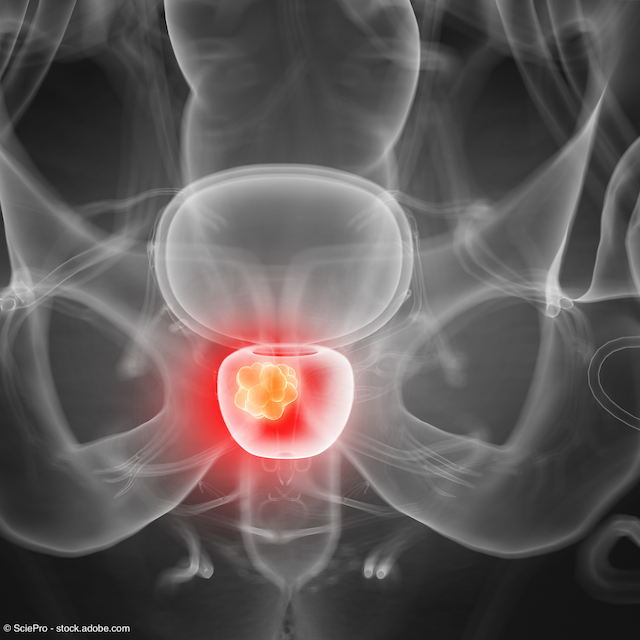- Benign Prostatic Hyperplasia
- Hormone Therapy
- Genomic Testing
- Next-Generation Imaging
- UTUC
- OAB and Incontinence
- Genitourinary Cancers
- Kidney Cancer
- Men's Health
- Pediatrics
- Female Urology
- Sexual Dysfunction
- Kidney Stones
- Urologic Surgery
- Bladder Cancer
- Benign Conditions
- Prostate Cancer
Hormone therapy does not increase radium-223 OS benefit in mCRPC
The addition of a second-generation hormone therapy to radium-223 (Xofigo) provided no additional overall survival (OS) benefit vs radium-223 alone in the third-line setting for patients with bone-dominant metastatic castration-resistant prostate cancer (mCRPC), according to study findings presented at the 2023 Society of Urologic Oncology Annual Meeting.1
The 3-year OS rates were 10% with radium-223 alone, 25% with radium-223 plus abiraterone, and 10% with radium-223 plus enzalutamide (log-rank test, p = .702).

Results from the single-institution retrospective study showed that there was not a statistically significant difference in OS when patients received radium-223 alone or with concomitant abiraterone acetate (Zytiga) or enzalutamide (Xtandi). The 3-year OS rates were 10% with radium-223 alone, 25% with radium-223 plus abiraterone, and 10% with radium-223 plus enzalutamide (log-rank test, p = .702).
The analysis included 57 patients with bone-dominant mCRPC. Patients were not eligible to enroll if they were receiving concurrent chemotherapy or had visceral metastases. At baseline, the mean patient age was 70.10 years (range, 60-92) and the median Gleason score was 9 (range, 5-10). The median pre–radium-223 PSA was 21 ng/ml (range, 0.6-964) and the median pre–radium-223 ALK-P was 91 (range, 12-275). Prior chemotherapy had been received by 95.60% of patients and 97.10% of patients had previously received a second-generation hormone therapy.
Of the 57 patients, 32 patients were treated with radium-223 alone and 25 patients were treated with radium-223 with a concomitant second-generation hormone therapy. Second generation hormone therapy consisted of enzalutamide (n = 17) or abiraterone acetate (n = 8).
Under the study protocol, patients received radium-223 every 4 weeks to complete a total of 6 injections. The median number of radium-223 cycles across all patients was 6 (range, 1-6).
In their conclusion, the authors wrote that “further prospective studies are warranted to validate the study findings.”
FDA approval of radium-223
The alpha-emitting particle radium-223 is approved by the FDA for the treatment of patients with castration-resistant prostate cancer, symptomatic bone metastases and no known visceral metastatic disease.2
In the phase 3, randomized, double-blind ALSYMPCA trial, radium-223 was shown to reduce the risk of death by 30% versus placebo in men with castration-resistant prostate cancer and bone metastases.3
The study included 921 patients randomized in a 2:1 ratio to receive 6 injections of radium-223 or placebo, both in combination with best supportive care. The final analysis showed a median OS of 14.9 months in the radium-223 arm compared with 11.3 months in the placebo arm (HR, 0.70; 95% CI, 0.58-0.83; P <.001).3
References
1. Lehner K, Ahmed M, Kendi AT, Andrews J, Kwon E. Concomitant second-generation hormone therapy with Radium-223 in the third-line setting: Does it improve overall survival? Presented at: 2023 Society of Urologic Oncology Annual Meeting. November 28 – December 1, 2023; Washington, DC. Abstract 24.
2. Bayer Receives U.S. FDA Approval for Xofigo® (radium Ra 223 dichloride) Injection as a New Treatment for Castration-Resistant Prostate Cancer with Bone Metastases. Published online May 15, 2013. Accessed November 29, 2023. https://tinyurl.com/mr2eyff6
3. Parker C, Nilsson S, Heinrich D, et al. Alpha emitter radium-223 and survival in metastatic prostate cancer. N Engl J Med. 2013;369(3):213-223. doi: 10.1056/NEJMoa1213755
